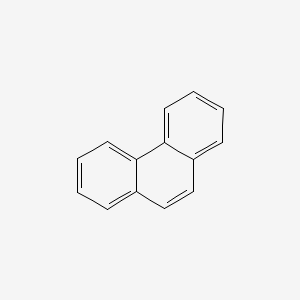D0159 | phenanthrene
| Toxicity | Dose | Time | Species | Model | Method | Action | Positive criterion | Reference |
|---|---|---|---|---|---|---|---|---|
| BASAL RESPIRATION | 100 µg/l | zebrafish | XFe24 Extracellular Flux Analyzer | Negative | 85 | |||
| BASAL RESPIRATION | 500 µg/l | zebrafish | XFe24 Extracellular Flux Analyzer | decrease | 85 | |||
| MAXIMAL RESPIRATION | 100 µg/l | zebrafish | XFe24 Extracellular Flux Analyzer | Negative | 85 | |||
| ATP TURNOVER | 100 µg/l | zebrafish | XFe24 Extracellular Flux Analyzer | decrease | 85 | |||
| PROTON LEAK | 100 µg/l | zebrafish | XFe24 Extracellular Flux Analyzer | Negative | 85 | |||
| PROTON LEAK | 500 µg/l | zebrafish | XFe24 Extracellular Flux Analyzer | increase | 85 | |||
| Pictogram | Signal | Statements | Precautionary Statement Codes |
|---|---|---|---|
  |
Warning |
Aggregated GHS information provided by 702 companies from 15 notifications to the ECHA C&L Inventory. Each notification may be associated with multiple companies. Reported as not meeting GHS hazard criteria by 1 of 702 companies. For more detailed information, please visit ECHA C&L website Of the 14 notification(s) provided by 701 of 702 companies with hazard statement code(s): H302 (99.71%): Harmful if swallowed [Warning Acute toxicity, oral] H400 (14.27%): Very toxic to aquatic life [Warning Hazardous to the aquatic environment, acute hazard] H410 (13.69%): Very toxic to aquatic life with long lasting effects [Warning Hazardous to the aquatic environment, long-term hazard] Information may vary between notifications depending on impurities, additives, and other factors. The percentage value in parenthesis indicates the notified classification ratio from companies that provide hazard codes. Only hazard codes with percentage values above 10% are shown. |
P264, P270, P273, P301+P312, P330, P391, and P501; (The corresponding statement to each P-code can be found at the GHS Classification page.) |
  |
Warning |
H302: Harmful if swallowed [Warning Acute toxicity, oral] H400: Very toxic to aquatic life [Warning Hazardous to the aquatic environment, acute hazard] H410: Very toxic to aquatic life with long lasting effects [Warning Hazardous to the aquatic environment, long-term hazard] |
P264, P270, P273, P301+P312, P330, P391, and P501; (The corresponding statement to each P-code can be found at the GHS Classification page.) |
 |
Warning |
H302: Harmful if swallowed [Warning Acute toxicity, oral] H317: May cause an allergic skin reaction [Warning Sensitization, Skin] |
P261, P264, P270, P272, P280, P301+P312, P302+P352, P321, P330, P333+P313, P363, and P501; (The corresponding statement to each P-code can be found at the GHS Classification page.) |
 |
Warning |
H302: Harmful if swallowed [Warning Acute toxicity, oral] H317: May cause an allergic skin reaction [Warning Sensitization, Skin] |
P261, P264, P270, P272, P280, P301+P312, P302+P352, P321, P330, P333+P313, P363, and P501; (The corresponding statement to each P-code can be found at the GHS Classification page.) |
| Organism | Test type | Route | Dose (normalized dose) | Effect | Source |
|---|---|---|---|---|---|
| mouse | LD50 | intravenous | 56mg/kg (56mg/kg) | U.S. Army Armament Research & Development Command, Chemical Systems Laboratory, NIOSH Exchange Chemicals. Vol. NX#00190, | |
| mouse | LD50 | oral | 700mg/kg (700mg/kg) | Hygiene and Sanitation Vol. 29(6), Pg. 19, 1964. | |
| mouse | LD50 | intraperitoneal | 700mg/kg (700mg/kg) | JNCI, Journal of the National Cancer Institute. Vol. 62, Pg. 911, 1979. | |
| 448J8E5BST | 85-01-8 | 9,10-Dehydrophenanthrene |
| 9-Phenanthrene | A841054 | AC-11346 |
| ACMC-20ajxi | AI3-00790 | AK113960 |
| AKOS008967330 | AS-12847 | BDBM50159266 |
| C11422 | CAS-85-01-8 | CCRIS 1233 |
| CHEBI:28851 | CHEMBL46730 | CS-0013733 |
| Coal tar pitch volatiles: phenanthrene | DB-043112 | DSSTox_CID_4254 |
| DSSTox_GSID_24254 | DSSTox_RID_77342 | DTXSID6024254 |
| EBD2205101 | EINECS 201-581-5 | FT-0631391 |
| HMS2268O22 | HSDB 2166 | HY-B1727 |
| InChI=1/C14H10/c1-3-7-13-11(5-1)9-10-12-6-2-4-8-14(12)13/h1-10 | KS-00000F9Y | KSC146C5L |
| LS-1845 | MCULE-8033936622 | MFCD00001168 |
| MLS002454437 | NCGC00091177-01 | NCGC00091177-02 |
| NCGC00091177-03 | NCGC00091177-04 | NCGC00254398-01 |
| NCGC00259187-01 | NSC 26256 | NSC-26256 |
| NSC26256 | P0079 | P0331 |
| P1310 | PEY | PHENANTHRENE |
| Phenanthracene | Phenanthren | Phenanthren [German] |
| Phenanthrenato | Phenanthrene 10 microg/mL in Acetonitrile | Phenanthrene 10 microg/mL in Cyclohexane |
| Phenanthrene 100 microg/mL in Acetonitrile | Phenanthrene 100 microg/mL in Methanol | Phenanthrene solution, 100 mug/mL in cyclohexane, analytical standard |
| Phenanthrene solution, certified reference material, 200 mug/mL in dichloromethane | Phenanthrene solution, certified reference material, 5000 mug/mL in methanol | Phenanthrene, 97% |
| Phenanthrene, 98% | Phenanthrene, analytical standard, for environmental analysis | Phenanthrene, certified reference material, TraceCERT(R) |
| Phenanthrene, pure | Phenanthrene, purum, for fluorescence, >=97.0% (HPLC) | Phenanthrene, sublimed grade, >=99.5% |
| Phenanthrene, zone-refined, >=99.5% | Phenanthrene-[U-13C] | Phenanthrin |
| Phenantrin | Q422037 | RTR-037980 |
| Ravatite | SBB058516 | SC-18157 |
| SMR000112025 | ST2413660 | ST50827630 |
| STL453632 | TR-037980 | TRA0005896 |
| TRA0047947 | Tox21_201638 | Tox21_300573 |
| UNII-0TNN3Q0D4D component YNPNZTXNASCQKK-UHFFFAOYSA-N | UNII-448J8E5BST | W-104097 |
| WLN: L B666J | YNPNZTXNASCQKK-UHFFFAOYSA-N | ZINC967819 |
| bmse000560 | phenanthrene-ring | phenanthroline; |
| CAS Number | 1173018-81-9, 1517-22-2, 334973-64-7, 78706-97-5, 85-01-8 |
| PubChem Compound | 995 |
| KEGG Compound ID | C11422 |
| ChEBI | 28851 |
| ChemSpider | 970 |
| Wikipedia | Phenanthrene |

